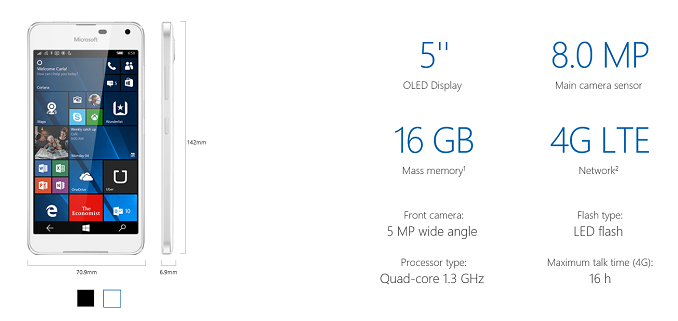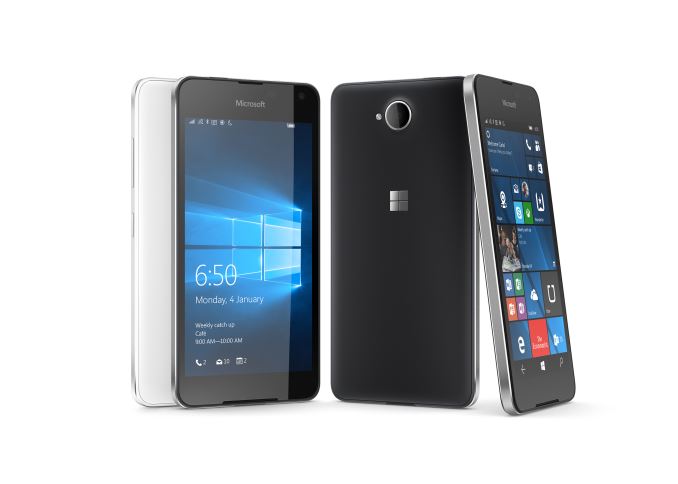Microsoft Launches The Business Focused Lumia 650
by Brett Howse on February 15, 2016 5:25 PM EST- Posted in
- Smartphones
- Microsoft
- Lumia
- Windows 10 Mobile

Today Microsoft launched their fourth phone in the x50 series, with the Lumia 650 being the latest Lumia to roll out of what used to be Nokia’s smartphone business. In July of 2015, Microsoft wrote down the majority of their acquisition of Nokia, laying off a large portion of the former Nokia employees. CEO Satya Nadella changed strategy on phones, and his new strategy has now been brought to fruition. Rather than the numerous handsets that Nokia was releasing to cover every single part of the market, Microsoft would step back on phone hardware, and focus on three areas instead. The first was the high end enthusiast phones, with are covered by the Lumia 950 and 950 XL announced last October. The low end is served by the $139 original asking price for the Lumia 550. That left just the third market that Nadella wanted to provide for, and that is the business market. Today’s Lumia 650 is being pushed as an affordable business phone. Let’s go over it and see how they did.
The first part is pretty easy. It is an affordable phone, with a suggested MSRP of just $199. It’s not the most affordable phone, but that’s not the goal here. The business phone is much more nuanced than price, and needs a bit more investigation.
What is going to make a phone successful in the business and enterprise markets is a lot bigger question than whether something is affordable. You need security, manageability, integration with company networks and applications, and more. Windows 10 put a lot of focus into endpoint security, with features like Data Loss Prevention, and integration with VPN functions as a start. Manageability would be handled through MDM solutions such as Microsoft System Center, or In-Tune, and Windows 10 has expanded the manageability of devices running this OS. Application integration can be handled through the Windows Store for Business and enterprises can leverage in-house developers with C# experience to write their own apps. I think on that note it can be successful, but if your company or enterprise leverages third-party mobile apps, it is certainly not a guarantee that there will be an app for Windows 10 Mobile.
But what I just described applies to any Windows 10 Mobile handset, and not specifically the Lumia 650. Biometric authentication is supported in Windows 10 Mobile, but not leveraged here. Continuum on Windows 10 Mobile allows you to use your phone as a PC by connecting it to a monitor and keyboard, but that functionality requires USB-C and a more powerful GPU than the Lumia 650 has, so it’s absent.
So despite being targeted towards business users, it lacks some of the most exciting functions for a business handset. So let’s stop looking at it as a business phone, and just look at it as a Windows 10 Mobile smartphone.
Windows 10 Mobile is of course the latest iteration of Microsoft’s phone operating system, but the new codebase is available for small tablets as well. It officially was released with the Lumia 950 and 950 XL’s launch in November, and many existing Windows Phone 8.1 handsets will be offered this as a no-charge update. It runs all of the apps from Windows Phone 8.1, as well as the new Universal Windows Platform apps designed for Windows 10, assuming the developer targets the app towards the phone screen size.
| Microsoft Lumia 650 | |
| SoC | Snapdragon 212 (quad-core Cortex A7 @ 1.3 GHz) |
| RAM/NAND | 1 GB RAM, 16 GB NAND + microSD 200 GB |
| Display | 5.0” 1280x720 ClearBlack AMOLED Corning Gorilla Glass 3 |
| Network | LTE up to 150 Mbps |
| Dimensions | 142 x 70.9 x 6.9 (mm) |
| Weight | 122 grams |
| Rear Camera | 8 MP, 1/4" CMOS, f/2.2, 28 mm focal length, LED Flash |
| Front Camera | 5 MP wide angle, f/2.2, 1280x720 video resolution |
| Battery | 2000 mAh, 3.8 V, 7.6 Wh |
| OS | Windows 10 Mobile |
| Connectivity | 802.11 b/g/n + BT 4.1, USB2.0, DLNA, FM Radio |
| Location Technologies | Cellular and Wi-Fi network positioning, A-GPS, A-GLONASS, BeiDou |
| SIM Size | Nano SIM |
The Lumia 650 is a 5-inch smartphone with a 1280x720 resolution AMOLED display. Luckily, it does support Glance, which is a low power mode where the time and some other information is on the display even when the phone is off (this is all configurable) which is one of my favorite Windows Phone features. It is powered by a Qualcomm Snapdragon 212, which is a quad-core Cortex A7 at 1.3 GHz. This should in theory be a small increase in performance over most of the previous Lumia phones powered by Snapdragon 400, since both used A7 cores but the 212 is clocked a bit faster. The A7 is the older 32-bit chip, but at the moment that’s not an issue anyway since Windows 10 Mobile is currently a 32-bit operating system. The GPU is Adreno 304 in the Snapdragon 212. The Lumia 650 comes with 1 GB of RAM, and 16 GB of storage, with microSD card expansion for up to another 200 GB. Windows 10 Mobile supports moving data to the SD card very easily, and you can set your default save location for apps, music, and more, to the internal or SD storage individually. The camera is an 8 MP sensor, but only 1/4” in size and it lacks the OIS of the higher end Lumia phones. The front camera is becoming more important, and the Lumia 650 has a 5 MP FFC with f/2.2 aperture and a wider field of view.
The Lumia 650 features a very thin and light design, coming in at just 6.9 mm in thickness and weighing in at only 122 grams. The removable back can be had in either black or white, and unlike the more expensive Lumia 950 and 950 XL, the 650 features a diamond cut anodized aluminum metal frame around the phone, which should give it a much better in-hand feel.
Despite the naming, the Lumia 650, to me, feels like a successor to the Lumia 830 with its metal frame and similar display size. The camera is likely not going to be quite as good, but my one big criticism of the Lumia 830 was the price, and the Lumia 650 comes in under half of what the 830 was sold for when it first launched. They certainly fixed that. I’m not sure where Windows 10 Mobile is headed, and maybe we’ll learn more at Microsoft’s Build developer conference at the end of March. The Lumia 650 will be available in the EU starting today and wider distribution later on.
Source: Microsoft












36 Comments
View All Comments
BurntMyBacon - Tuesday, February 16, 2016 - link
@Danvelopment: "No Continuum ... This isn't a business phone, it's a phone that can be used for business."Not sure I agree with ya there. No wait, I AM sure I agree with you. There will be plenty of business users for which continuum makes little sense and a more capable portable device to do work out of the office makes more sense. However, continuum makes a lot of sense when you only need email, internet, and basic presentation materials. You could bring your dock and use continuum on your client's big screen or projector for presentations for some use cases.
In any case, businesses for which continuum doesn't work well could still use this phone (or many others) at no real advantage or loss. However, businesses for which continuum does work can change their work flow and simplify or expedite how they go about business. Hence, I agree with your assessment of the distinction between business phones and phones that can be used for business and the fact that the continuum feature is a business phone class feature.
xthetenth - Tuesday, February 16, 2016 - link
If it helps, the insider program has supported the 1520 for months, and I haven't had problems with my 1520 since december.Danvelopment - Tuesday, February 16, 2016 - link
Will have another look but I've already returned to WP 8.1 once. What makes me wary is MS has dropped the 1520 from its most recent release material, and it was supposed to be one of the first. That tells me MS doesn't have confidence in its stability.LiverpoolFC5903 - Monday, February 15, 2016 - link
A Snapdragon 212 just doesnt make any sense at all to me, especially in a phone costing north of 200 USD. I do understand Windows 10 mobile is ok running on low end systems, but c'mon, an soc from Qualcom's cheapest range (200 series) is taking it too far. At least a Snapdragon 615/16 would have sufficed here even if it meant a 20 USD increase in end price.I have been a huge windows phone fan since 2013 and I was really looking forward to the launch of the supposed upper mid range 7XX and 8XX series with decent processors and great cameras. Looks like its either going to be the very top end (808/10) or very low end (200 series) and nothing in between.
I am sorry Microsoft, but phones like this one offer no real value proposition to the consumer. A Lumia 1320 at 200 USD is still a better phone than this, which says it all really.
showb1z - Tuesday, February 16, 2016 - link
Agreed. I'm more than willing to give windows mobile a shot but they need to come up with a compelling $300-400 midrange offering. This isn't cutting it at all.MrSpadge - Tuesday, February 16, 2016 - link
+1 for lack of midrange SoCs. They don't even switch to A53 cores on the low end..sudipt123 - Wednesday, February 24, 2016 - link
MSFT was supposed to launch a 750/850 codenamed -Honjo which was to have a Snapdragon 615. Seems all those plans are vanished into thin airDaniel Egger - Tuesday, February 16, 2016 - link
The feature making this phone potentially interesting to me (as a replacement for my 820) is the OLED display with the glance screen. The rest is rather meh... Also I do prefer smaller screens, 5" is already too large for my taste.Before I buy this however I'll definitely wait for the Win10 upgrade for my 820. M$ fscked me twice already with their sudden change of mind after a long wait period, a third strike and they're definitely out.
xthetenth - Tuesday, February 16, 2016 - link
The insider program does work if you really want the update.ABR - Tuesday, February 16, 2016 - link
In terms of size, weight, and OLED screen, this is really the first successor to the Lumia 925. Unfortunately its almost 3 years later and barely an improvement. Without biometrics or continuity, a small CPU speed bump and slight weight decrease are not enough to get me to buy. Not to mention, the extra inch in height to accomodate a blank space, and replacement of hardware with software buttons, and loss of a camera button are minuses.